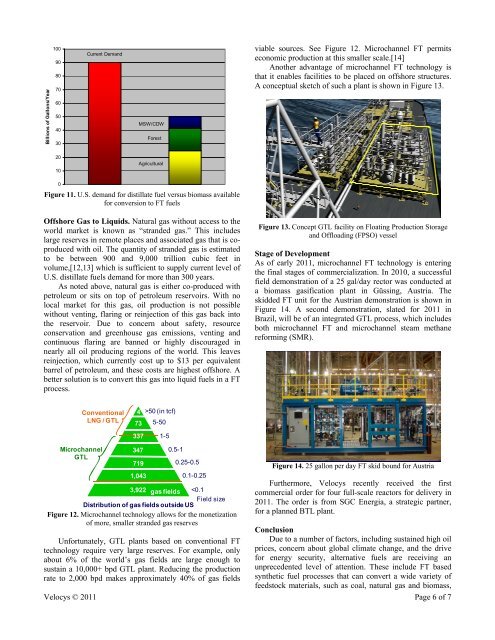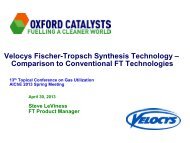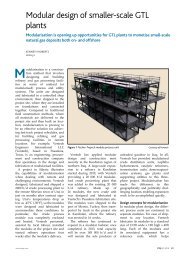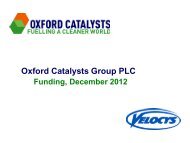Improved Fischer-Tropsch Economics Enabled by Microchannel ...
Improved Fischer-Tropsch Economics Enabled by Microchannel ...
Improved Fischer-Tropsch Economics Enabled by Microchannel ...
Create successful ePaper yourself
Turn your PDF publications into a flip-book with our unique Google optimized e-Paper software.
Billions of Gallons/Year<br />
100<br />
90<br />
80<br />
70<br />
60<br />
50<br />
40<br />
30<br />
Current Demand<br />
MSW/CDW<br />
Forest<br />
viable sources. See Figure 12. <strong>Microchannel</strong> FT permits<br />
economic production at this smaller scale.[14]<br />
Another advantage of microchannel FT technology is<br />
that it enables facilities to be placed on offshore structures.<br />
A conceptual sketch of such a plant is shown in Figure 13.<br />
20<br />
10<br />
Agricultural<br />
0<br />
Figure 11. U.S. demand for distillate fuel versus biomass available<br />
for conversion to FT fuels<br />
Offshore Gas to Liquids. Natural gas without access to the<br />
world market is known as “stranded gas.” This includes<br />
large reserves in remote places and associated gas that is coproduced<br />
with oil. The quantity of stranded gas is estimated<br />
to be between 900 and 9,000 trillion cubic feet in<br />
volume,[12,13] which is sufficient to supply current level of<br />
U.S. distillate fuels demand for more than 300 years.<br />
As noted above, natural gas is either co-produced with<br />
petroleum or sits on top of petroleum reservoirs. With no<br />
local market for this gas, oil production is not possible<br />
without venting, flaring or reinjection of this gas back into<br />
the reservoir. Due to concern about safety, resource<br />
conservation and greenhouse gas emissions, venting and<br />
continuous flaring are banned or highly discouraged in<br />
nearly all oil producing regions of the world. This leaves<br />
reinjection, which currently cost up to $13 per equivalent<br />
barrel of petroleum, and these costs are highest offshore. A<br />
better solution is to convert this gas into liquid fuels in a FT<br />
process.<br />
Figure 13. Concept GTL facility on Floating Production Storage<br />
and Offloading (FPSO) vessel<br />
Stage of Development<br />
As of early 2011, microchannel FT technology is entering<br />
the final stages of commercialization. In 2010, a successful<br />
field demonstration of a 25 gal/day rector was conducted at<br />
a biomass gasification plant in Güssing, Austria. The<br />
skidded FT unit for the Austrian demonstration is shown in<br />
Figure 14. A second demonstration, slated for 2011 in<br />
Brazil, will be of an integrated GTL process, which includes<br />
both microchannel FT and microchannel steam methane<br />
reforming (SMR).<br />
Conventional<br />
LNG / GTL<br />
4 >50 (in tcf)<br />
73 5-50<br />
337 1-5<br />
<strong>Microchannel</strong><br />
GTL<br />
347<br />
719<br />
1,043<br />
0.5-1<br />
0.25-0.5<br />
0.1-0.25<br />
3,922 gas fields











